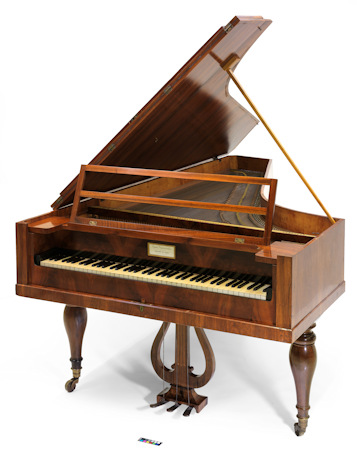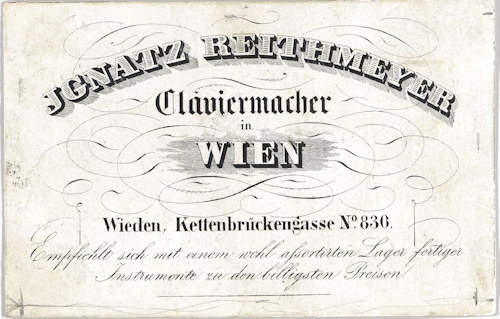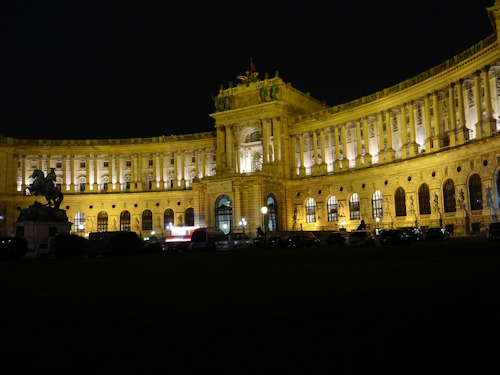There are pianos. Then there’s Mahler’s piano. Or Liszt’s. Or the one they say Haydn and Beethoven might have played. All these items live in the historical musical instrument collection.
- Large collection of antique instruments
- Unique items with famous connections
- Track the evolution of technologies and instruments
- Part of the Weltmuseum complex
- Book Weltmuseum tickets* online
- See also:
- Haus der Musik
- Vienna location guides for famous composers
Keyboards & more

(A fortepiano from 1825–1845, manufactured by Ignaz Bösendorfer and fomerly owned by the famous writer and friend of Beethoven, Franz Grillparzer; Wien Museum Inv.-Nr. Grillparzer 131; reproduced under the terms of the CC BY 4.0 license; photo by Birgit and Peter Kainz, Wien Museum. Illustrative only.)
As you might imagine, Vienna has one or two historical musical instruments within the city limits. And a large number of them form the special collection housed within the Weltmuseum part of the Neue Burg extension to the central Hofburg palace.
The rooms displaying the collection begin at one end of the Neue Burg and stretch across to the other end, creating a linear journey through time mirrored in their contents.
You start, for example, with the 1500s and finish with the late Romantic period and 20th century. Numerous instruments fill display cases or stand free for even closer observation.
This chronological layout allows you to follow the evolution of designs and technologies, and admire the work of such manufacturers as Graf, Streicher, and Bösendorfer.
Further themes are music and court life, as well as the instruments of famous composers and musicians (Vienna has rather a lot of these, too).

(Entrance to the musical instrument collection)
So, for example, the collection begins with images of the triumphal entry of Emperor Maximilian into Vienna, with real examples of the 16th-century instruments found in the illustrations.
These instruments cover a rich diversity of names and forms. Discover the Spinet and Regal or the Chitarrone, or shaped wind instruments that look as if a hallucinating student of Greek mythology designed them.
My favourite name is the Clavicytherium, which sounds like a herbivorous dinosaur but is actually a kind of harpsichord.
As you progress, the focus increasingly shifts to stringed instruments and keyboards, inevitably ending with the great grand pianos of the early 20th century.
Personal collection highlights
The main items of interest for the casual visitor are, perhaps, those instruments that once passed through the hands of some of the world’s greatest musicians and composers.
I will never cease to marvel at being able to stand next to pianos that the likes of Gustav Mahler or Ludwig van Beethoven once played.
As in many museums in Vienna, you feel an almost physical connection to such historical figures of the past.
The collection includes, for example:
- A fortepiano believed to have been played by both Haydn and Beethoven
- A square piano that Schubert used when composing
- An 1839 grand piano that once felt the touch of Brahms
- The Érard piano used by Franz Liszt for compositions, lessons and private concerts while in Rome
- A 1902 piano owned by Mahler

(Visiting card of the piano builder, Ignatz Reithmeyer, Kettenbrückengasse, Wieden 836 in Vienna from around 1840, Wien Museum Inv.-Nr. 231875/77, excerpt reproduced with permission under the terms of the CC0 licence. Illustrative only)
However, the beauty of the instruments lies not only in their associations but in the workmanship, artistry and innovation of their designs. For example:
- Dual purpose instruments, such as a glorious 17th-century lacquered and mosaiced cabinet with a built-in keyboard, or a table inlaid with ebony and ivory that turns out to be a pipe organ
- A Bösendorfer grand piano built in the 1860s for the Paris World Fair. Imagine an opulent salon in a majestic palace. Now imagine that salon in the form of a grand piano: all neoclassical wood inlays, decorated scrollwork, and gilded female figures
- A double guitar from 1690, almost 300 years before the likes of Jimmy Page would make double-necked guitars famous
- Fortepianos from the late 18th century; the kind that Jane Austen’s heroines (or Jane Austen herself) might have played on
- Gorgeous harps with golden scrolling and covered in delicate paintings
- A travelling clavichord complete with quill holder for those last minute changes to the sheet music
- Gilded mid-18th century trumpets used at court occasions during the reign of Empress Maria Theresa

(The Neue Burg at night)
Enjoy one or two highlights away from the instruments, too. For example:
- The Marble Hall room at the centre of the collection, filled with marble columns, stucco decoration and ceiling paintings
- A coloured wax bust of Joseph Haydn, created while he was still alive in around 1800
- Portraits of Beethoven (1823) and Schubert (1814)
- An 1898 bust of Brahms by Ilse Conrat (who also designed his gravestone)
Those with a greater understanding of the history and technology of musical instruments will value the way the items on display illustrate the progressive instrument design.
And those of a creative bent will appreciate the simple artistic brilliance of many of the items, as seen in the twists and curves, the patterned inlays, the careful decoration or the glorious aesthetics of the physical designs.
Tickets & visitor tips
To access the instrument collection, you just need an entrance ticket for or from the Weltmuseum.
(Booking service provided by Tiqets.com*, who I am an affiliate of)
Some quick tips:
- If you want to hear some instruments, rather than just look at them:
- Pick up an audioguide
- Check if one of the rare morning concerts is scheduled, featuring the very instruments you might see on display
- Consider one of my general classical concert recommendations
- Almost all written information is in German and English. Sometimes the language used goes over the heads of anyone not familiar with the vocabulary of musical instruments
- You go up two floors and pass through the Imperial Armoury section to reach the instruments. I’ll admit I got a little confused trying to find the way in, but then I’m an idiot. Friendly staff pointed me in the right direction
- The ground floor of the Weltmuseum has all the facilities: cloakroom, lockers, etc. (the café in the magnificent atrium makes an excellent place to break your sightseeing tour of the Hofburg)
- As a modern museum of ethnology, the Weltmuseum itself offers numerous fascinating exhibits on world cultures, with regular special exhibitions
- The same part of the building housing the Weltmuseum also houses the Hofburg info centre and Imperial shop, so you might want to look at them while you’re there
- A Vienna Pass gets you one-time free entry into the Weltmuseum, including the instruments collection
- For more instruments and/or items related to the great Viennese composers, consider a visit to the Haus der Musik and the various musician residences managed by the Wien Museum
How to get to the instrument collection
It’s central and easily accessed on foot or by public transport. See the Weltmuseum article for details.
Address: Heldenplatz, 1010 Vienna | Website
